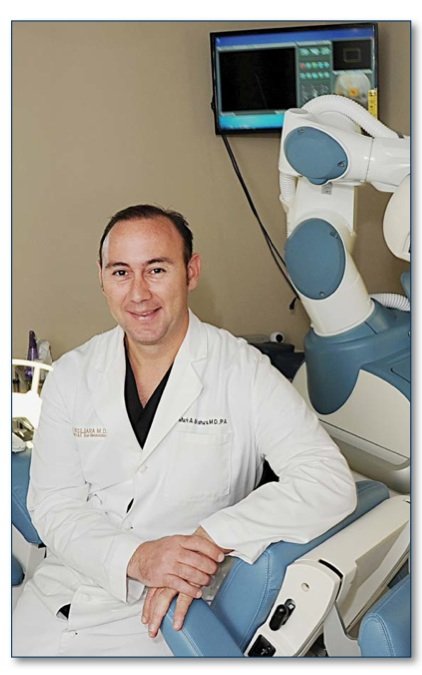Like good health and youth, most of us take a thick head of hair for granted — that is, until it is gone. For many people, hair transplant procedures can help bring back the appearance of a full — or at least a fuller — head of hair.
Overview of Robotic Hair Transplant Procedures
Robotic hair transplant surgery is a logical advance in the technology of Follicular Unit Extraction (FUE). The potential advantages of Robotic FUE (R-FUE) over traditional FUE procedures include:
- Increased accuracy of harvesting grafts to minimize damage to follicles
- Ability to use FUE in a wider variety of patients
- Reduced harvesting time
- Increased graft survival
Follicular Unit Extraction is a harvesting procedure where hair is removed directly from the donor region of the scalp as individual, naturally-occurring groups of 1-4 hairs. The technique consists of two main steps: 1) Separation of the follicular units from the surrounding skin, and 2) Extraction (removal) of the follicular units from the scalp.
Step one, the separation of the follicular units from the surrounding donor tissue, is a highly repetitive and labor intensive process that requires great precision. This step requires the centering of the punch over the follicular unit and the alignment of the dissecting instrument with the follicles to prevent damage. This step, which must be repeated manually hundreds to thousands of times in a typical FUE procedure, subjects the patient to significant human variability and error.
The problem associated with the initial step of separating follicular units from the surrounding tissue has been a major challenge for FUE practitioners. A significant advance towards minimizing trauma to follicular units in this first step was to divide it into two parts; sharp, followed by blunt dissection. This additional step reduces the chance of injury to the lower part of the follicles during dissection. The current robotic system is based on this concept.
Risks and Costs of Treatment
The cost of hair transplantation will depend largely on the amount of hair to be transplanted, but it generally ranges from $4,000 to $15,000. The procedure is rarely covered by insurance.
As with any surgical procedure, hair transplantation carries risks, including bleeding and infection. Other risks that can occur with hair transplants include scarring and unnatural-looking new hair growth.
Around the time new hair growth starts, some people experience inflammation or infection of the hair follicles, called folliculitis. This can be relieved with antibiotics and compresses. Another potential risk is the sudden loss of transplanted hair, called shock loss. Fortunately, this hair loss is rarely permanent.
If you are bothered by thinning hair or balding, hair transplantation can significantly improve your appearance and self-confidence. However, it is important to understand that hair transplantation is just that — transplantation of hair you already have to a place where it is more visible. It does not create new hair.
To minimize the risks and improve the success of surgery, it is important to undergo hair transplantation only if you are healthy. You should always discuss the potential risks and benefits of any surgery with your doctor.
This Information is brought to you courtesy of Dr. Bishara and The Paragon Plastic Surgery & Med Spa











